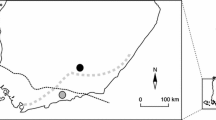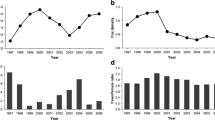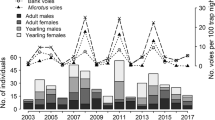Summary
We studied responses of stoats and least weasels to fluctuating vole abundances during seven winters in western Finland. Density indices of mustelids were derived from snow-tracking, diet composition from scat samples, and vole abundances from snap-trapping. Predation rate was estimated by the ratio of voles to mustelids and by the vole kill rate by predators (density of predator x percentage of voles in the diet). We tested the following four predictions of the hypothesis that small mustelids cause the low phase of the microtine cycle. (1) The densities of predators should lag well behind the prey abundances, as time lags tend to have destabilizing effects. The densities of stoats fluctuated in accordance with the vole abundances, whereas the spring densities of least weasels tracked the vole abundances with a half-year lag and the autumn densities with a 1-year lag. (2) Predators should not shift to alternative prey with declining vole densities. The yearly proportion of Microtus voles (the staple prey) in the diet of stoats varied widely (range 16–82%) and was positively correlated with the winter abundance of these voles. In contrast, the same proportion in the food of least weasels was independent of the vole abundance. (3) The ratio of voles to small mustelids should be smallest in poor vole years and largest in good ones. This was also observed. (4) Vole densities from autumn to spring should decrease more in those winters when vole kill rates are high than when they are low. The data on least weasels agreed with this prediction. Our results from least weasels were consistent with the predictions of the hypothesis, but stoats behaved like “semi-generalist” predators. Accordingly, declines and lows in the microtine cycle may be due to least weasel predation, but other extrinsic factors may also contribute to crashes.
Similar content being viewed by others
References
Andersson M, Erlinge S (1977) Influence of predation on rodent populations. Oikos 29: 591–597
Bang P, Dahlström P (1975) Jälkiä luonnossa. Nisäkkäiden ja lintujen jälkiä ja jätöksiä (in Finnish) Otava, Keuruu
Day MG (1966) Identification of hair and feather remains in the gut and faeces of stoats and weasels. J Zool Lond 148: 201–217
Day MG (1968) Food habits of British stoats (Mustela erminea) and weasels (Mustela nivalis). J Zool Lond 150: 485–497
Debrot S (1981) Trophic relations between the stoat (Mustela erminea) and its prey, mainly the water vole (Arvicola terrestris Sherman). In: Chapman JA, Pursley D (eds), Worldwide Furbearer Conference Proceedings. Donneley and Sons, Falls Church, Virginia, pp 1259–1289
Debrot S, Fivaz G, Mermod C, Weber JM (1982) Atlas des poils de mammiferes d'Europe. Inst Zool de l'Universite de Neuchatel, Neuchatel
Delattre P (1983) Density of weasel (Mustela nivalis) and stoat (Mustela erminea) in relation to water vole abundance. Acta Zool Fenn 174: 221–222
Delattre P (1984) Influence de la pression de predation exercée par une population de belettes (Mustela nivalis L.) sur un peuplement de Microtidae. Acta Oecol Oecol Gener 5: 283–300
Desy EA, Batzli GO (1989) Effects of food availability and predation on prairie vole demography: a field experiment. Ecology 70: 411–421
Erlinge S (1974) Distribution, territoriality and numbers of the weasel (Mustela nivalis) in relation to prey abyndance. Oikos 25: 308–314
Erlinge S (1975) Feeding habits of the weasel Mustela nivalis in relation to prey abundance. Oikos 26: 378–384
Erlinge S (1979) Adaptive significance of sexual dimorphism in weasels. Oikos 33: 233–245
Erlinge S (1981) Food preference, optimal diet and reproductive output in stoats Mustela erminea in Sweden. Oikos 36: 303–315
Erlinge S (1983) Demography and dynamics of a stoat Mustela erminea population in a diverse community of vertebrates. J Anim Ecol 52: 705–726
Erlinge S (1987) Predation and noncyclicity in a microtine population in southern Sweden. Oikos 50: 347–352
Erlinge S, Göransson G, Hansson L, Högstedt G, Liberg O, Nilsson IN, Nilsson T, v Schantz T, Sylvén M (1983) Predation as a regulating factor in small rodent populations in southern Sweden. Oikos 40: 36–52
Erlinge S, Göransson G, Högstedt G, Jansson G, Liberg O, Loman J, Nilsson IN, v Schantz T, Sylvén M (1984) Can vertebrate predators regulate their prey? Am Nat 123: 125–133
Finerty JP (1980) The population ecology of cycles in small mammals. Mathematical theory and biological fact. Yale University Press, New Haven and London
Fitzgerald BM (1977) Weasel predation on a cyclic population of the Montane vole (Microtus montanus) in California. J Anim Ecol 46: 367–397
Fitzgerald BM (1981) Predatory birds and mammals. In: Bliss LC, Cragg JB, Heal DW, Moore JJ (eds) Tundra ecosystems: A Comparative Analysis. Cambridge University Press, Cambridge, pp 485–508
Frank F (1974) Wurfzahl und Wurffolge beim nordischen Wiesel (Mustela nivalis rixosa Bangs 1896). Z Säugetierk 39: 248–250
Goszczynski J (1977) Connections between predatory birds and mammals and their prey. Acta Theriol 22: 399–430
Hanski I, Hansson L, Henttonen H (1991) Specialist predators, generalist predators, and the microtine rodent cycle. J Anim Ecol 60: 353–367
Hansson L (1984) Predation as the factor causing extended low densities in microtime cycles. Oikos 43: 255–256
Hansson L (1987) An interpretation of rodent dynamics as due to trophic interactions. Oikos 50: 308–319
Hansson L, Henttonen H (1985) Gradients in density variations of smali rodents: the importance of latitude and snow cover. Oecologia 67: 394–402
Hansson L, Henttonen H (1988) Rodent dynamics as community processes. Trends Ecol Evol 3: 195–200
Heidt GA (1970) The least weasel, Mustela nivalis L. Developmental biology in comparison with other North American Mustela. Michigan State Univ, Publ Mus (Biol Ser) 4: 227–282
Henttonen H (1985) Predation causing extended low densities in microtine cycles: further evidence from shrew dynamics. Oikos 44: 156–157
Henttonen H (1987) The impact of spacing behavior in microtine rodents on the dynamics of least weasels Mustela nivalis — a hypothesis. Oikos 50: 366–370
Hentonen H, Oksanen T, Jortikka A, Haukisalmi V (1987) How much do weasels shape microtine cycles in the northern Fennoscandian taiga? Oikos 50: 353–365
Heske EJ, Bondrup-Nielsen S (1990) Why spacing behaviour does not stabilize density in cyclic populations of microtine rodents. Oecologia 83: 91–98
Heske EJ, Ims RA, Steen H (1991) Four experiments on a Norwegian microtine assemblage during a summer decline. Biol J Linn Soc (in press)
Holling CS (1959) Some characteristics of simple types of predation and parasitism. Can Entomol 91: 385–398
Järvinen A (1990) Changes in the abundance of birds in relation to small rodent density and predation rate in Finnish Lapland. Bird Study 37: 36–39
Kaikusalo A (1982) Myyrät ja Tunturi-Lapin nisäkäspedot (in Finnish) Suomen Riista 29: 89–92
King CM (1975) The home range of the weasel Mustela nivalis in and English woodland. J Anim Ecol 44: 639–669
King CM (1980) The weasel Mustela nivalis and its prey in an English woodland. J Anim Ecol 49: 127–159
King CM (1983) The life-history strategies of Mustela nivalis and Mustela erminea. Acta Zool Fenn 174: 183–184
King CM (1989) The natural history of weasels and stoats. Christopher Helm, London
Korpimäki E (1981) On the ecology and biology of Tengmalm's Owl (Aegolius funereus) in Southern Ostrobothnia and Suomenselkä western Finland. Acta Univ Oul A 118 Biol 13: 1–84
Korpimäki E (1984) Population dynamics of birds of prey in relation to fluctuations in small mammal populations in western Finland. Ann Zool Fenn 21: 287–293
Korpimäki E (1985) Rapid tracking of microtine populations by their avian predators: possible evidence for stabilizing predation. Oikos 45: 281–284
Korpimäki E (1986) Predation causing synchronous decline phases in microtine and shrew populations in western Finland Oikos 46: 124–127
Korpimäki E, Hakkarainen H (1991), Fluctuating food supply affects the clutch size of Tengmalm's Owl independent of laying date. Oecologia 85: 543–552
Korpimäki E, Norrdahl K (1987) Low proportion of shrews in the diet of small mustelids in western Finland. Z Säugetierk 52: 257–260
Korpimäki E, Norrdahl K (1989a) Predation of Tengmalm's owls: numerical responses, functional responses and dampening impact on population fluctuations of voles. Oikos 54: 154–164
Korpimäki E, Norrdahl K (1989b) Avian predation on mustelids in Europe 2: impact on small mustelid and microtine dynamics — a hypothesis. Oikos 55: 273–276
Korpimäki E, Norrdahl K (1989c) Avian predation on mustelids in Europe 1: occurrence and effects on body size variation and life traits. Oikos 55: 205–215
Korpimäki E, Norrdahl K (1991) Numerical and functional responses of Kestrels, Short-eared Owls and Long-eared Owls to vole densities. Ecology 72: 814–826
Korpimäki E, Norrdahl K Do breeding nomadic avian predators dampen population fluctuations of small mammals? Oikos (in press)
Korpimäki E, Sulkava S (1987) Diet and breeding performance of Ural Owls Strix uralensis under fluctuating food conditions. Ornis Fenn 64: 57–66
Krebs CJ, Myers JH (1974) Population cycles in small mammals. Adv Ecol Res 8: 267–399
Lidicker WZJr (1988) Solving the enigma of microtine “cycles”. J Mammal 69: 225–235
Lindén H, Wikman M (1983) Goshawk predation on tetraonids: availability of prey and diet of the predator in the breeding season. J Anim Ecol 52: 953–968
MacLean SF Jr, Fitzgerald BM, Pitelka FA (1974) Population cycles in Arctic Lemmings: winter reproduction and predation by weasels. Arct Alp Res 6: 1–12
Maher WJ (1967) Predation by weasels on a winter population of lemmings Bank Islands Northwest Territories. Can Field-Nat 18: 248–250
Murdoch WW, Oaten A (1975) Predation and population stability. Adv Ecol Res 9: 2–131
Nyholm E (1959) Kärpästä ja lumikosta ja niiden talvisista elinpiireistä (in Finnish) Suomen Riista 13: 106–166
Rinta-Jaskari T (1990) Kärpän (Mustela erminea) ja lumikon (Mustela nivalis) talviravinto eteläpohjalaisella peltolakeudella: vuosittainen, lajinsisäinen ja lajien välinen vaihtelu (in Finnish) MS thesis, Department of Zoology, University of Oulu, Finland
Sandell M (1985) Ecology and behaviour of the stoat Mustela erminea and a theory on delayed implantation. Dissertation, Department of Animal Ecology, University of Lund, Sweden
Siivonen L, Heikura K, Sulkava S (1982) Jäljet lumessa. Opas nisäkkäiden ja lintujen talvisista jäljistä (in Finnish) Gummerrus, Jyväskylä
Simms DA (1979) North American weasels: resource utilization and distribution. Can J Zool 57: 504–520
Skarén UAP (1983) Lumikko (in Finnish). In: Koivisto I (ed), Suomen eläimet 1. Weilin + Göös, Espoo, pp 225–227
Solomon ME (1949) The natural control of animal population. J Anim Ecol 18: 1–35
Taylor RJ (1984) Predation. Chapman and Hall, London
Tapper S (1979) The effect of fluctuating vole numbers (Microtus agrestis) on a population of weasels (Mustela nivalis) on farmland. J Anim Ecol 48: 603–617
Vershinin AA (1972) The biology and trapping of the ermine in Kamchatka. In: King CM (ed), Biology of Mustelids: some Soviet research, vol. 2. DSIR Bulletin 227, Wellington
Ward RMP, Krebs CJ (1986) Behavioural responses of lynx to declining snowshoe hare abundance. Can J Zool 63: 2817–2824
Ylönen H (1989) Weasels Mustela nivalis suppress reproduction in cyclic bank voles Clethrionomys glareolus. Oikos 55: 138–140
Author information
Authors and Affiliations
Rights and permissions
About this article
Cite this article
Korpimäki, E., Norrdahl, K. & Rinta-Jaskari, T. Responses of stoats and least weasels to fluctuating food abundances: is the low phase of the vole cycle due to mustelid predation?. Oecologia 88, 552–561 (1991). https://doi.org/10.1007/BF00317719
Received:
Accepted:
Issue Date:
DOI: https://doi.org/10.1007/BF00317719




